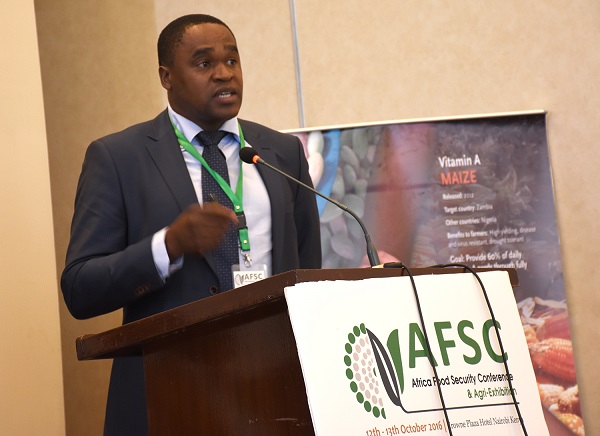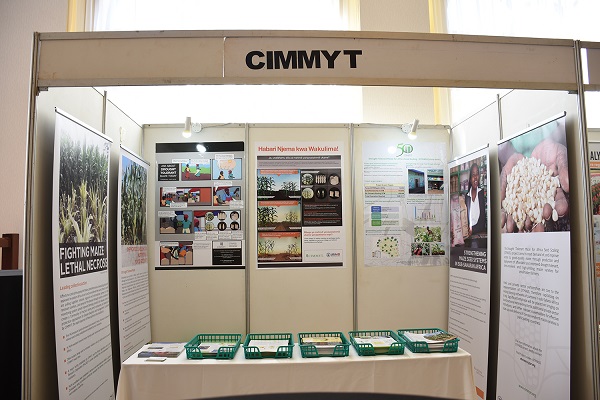
NAIROBI, Kenya (CIMMYT) — Is there too much talk and not enough action regarding food security in Africa? For two days, stakeholders in the agricultural sector met in Nairobi, Kenya, for the 4th Africa Food Security Conference (AFSC), held at the Crowne Plaza Hotel on 12 and 13 October 2016. Experts in crop production, nutrition, agricultural inputs, global development and even microfinance, chimed in on the seemingly endless task of making Africa food secure. Speakers at the event called for a lasting solution to this challenge, citing low crop productivity, food loss, and wastage from under-developed food value chains as some of the biggest impediments to food security. However, climate change and variability remain the most devastating occurrences to farmers across the globe, and sub-Sahara Africa in particular.
According to a FAO report on global food losses and food waste, the food currently lost in Africa could feed 300 million people. The report also mentions that food waste and losses in developing countries occur at early stages of the food value chain, where constraints in harvesting techniques, finances and technical know-how exist. Further, 40 percent of losses in developing countries occur at post-harvest and processing levels, translating into lost income for small farmers and higher prices for poor consumers.
While infrastructure investments in the food value chain can help reduce the amount of food lost or wasted, and in effect feed more people, achieving a truly food secure Africa means building resilience to climate change. To do so, it is critical that production technologies are developed to adapt to the changing climate, natural resources such as land and water are properly utilized, and the environment left intact.
In the last decade, the International Maize and Wheat Improvement Center (CIMMYT) has responded swiftly to the ravages of climate change, developing responses that are accessible and affordable to smallholder farmers in sub-Sahara Africa, in whose farms the bulk of food consumed is grown.
In his presentation at the AFSC, Rodney Lunduka, socioeconomist at CIMMYT, shared that in addition to loss of yield in moderate drought, maize yield losses double when temperatures exceed 30°C, severely affecting farmers’ productivity.

“CIMMYT’s two major solutions to building farmers’ resilience to climate change are a combination of drought tolerant (DT) maize varieties, and good agronomic practices, which our studies show are being quickly adopted,” Lunduka says, adding: “this combined approach has the potential to double farmers’ yields, translating to more food and income at household level.”
Preliminary results from a household survey on the impact of DT maize in southern Africa reveal that a simple switch from non-DT maize varieties to DT maize varieties can increase farmers’ total maize production by 0.7 tons per hectare (ha) on average. The study spanned 4,700 households in Angola, Malawi, Mozambique, Zambia and Zimbabwe between 2013 and 2015. In Zimbabwe, farmers would produce 0.6 tons more yield/ha with DT maize, where the average is about 0.8 to one ton per hectare (t/ha) with non-DT maize. In Malawi, farmers were able to produce one ton more per ha – on average 1.3 to 1.5 t/ha – when DT varieties and good agronomic practices were combined.
“Good farm practices such as residue retention and intercropping with legumes are popular, the former for its simplicity, and the latter for its income potential,” says Lunduka on adopting good agronomic practices. “It is common to see maize intercropped with soya beans, cow peas, groundnuts, or pigeon peas, which most farmers can afford and have the skills to plant.”
While uptake of DT maize varieties is gradually increasing in sub-Sahara Africa, there still exist some barriers to total adoption, notably unfavorable government policies, and production and purchase of old varieties by seed producers and farmers respectively. Government policies can encourage replacement of old varieties, for instance, by offering subsidies on seed production to companies that produce improved varieties.
Read Lunduka’s presentation at the AFSC here.

 Nutrition, health and food security
Nutrition, health and food security 
